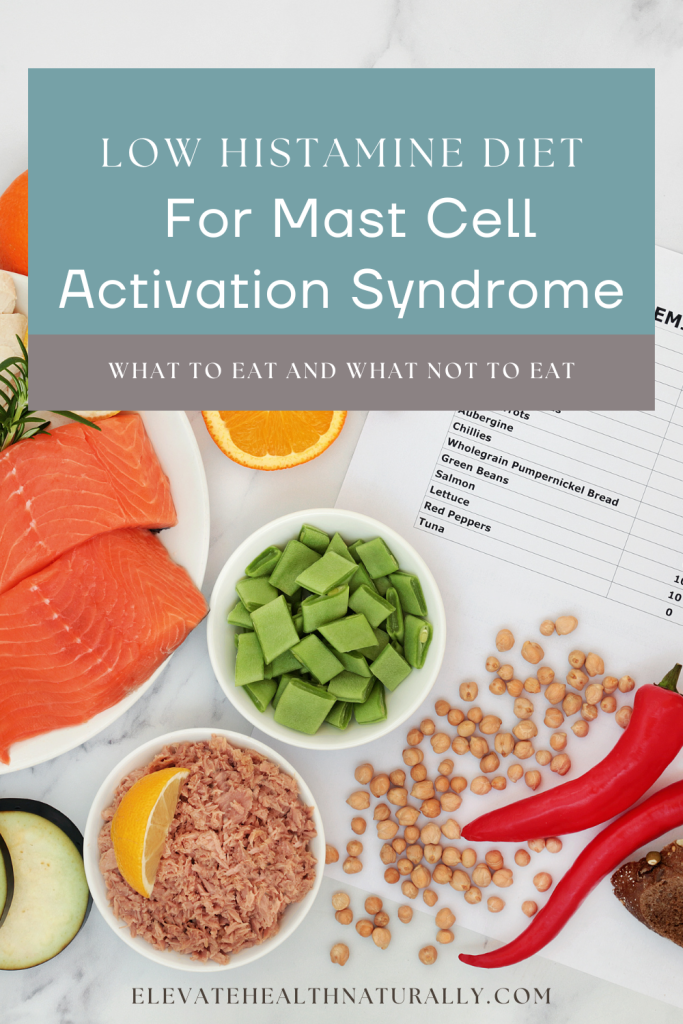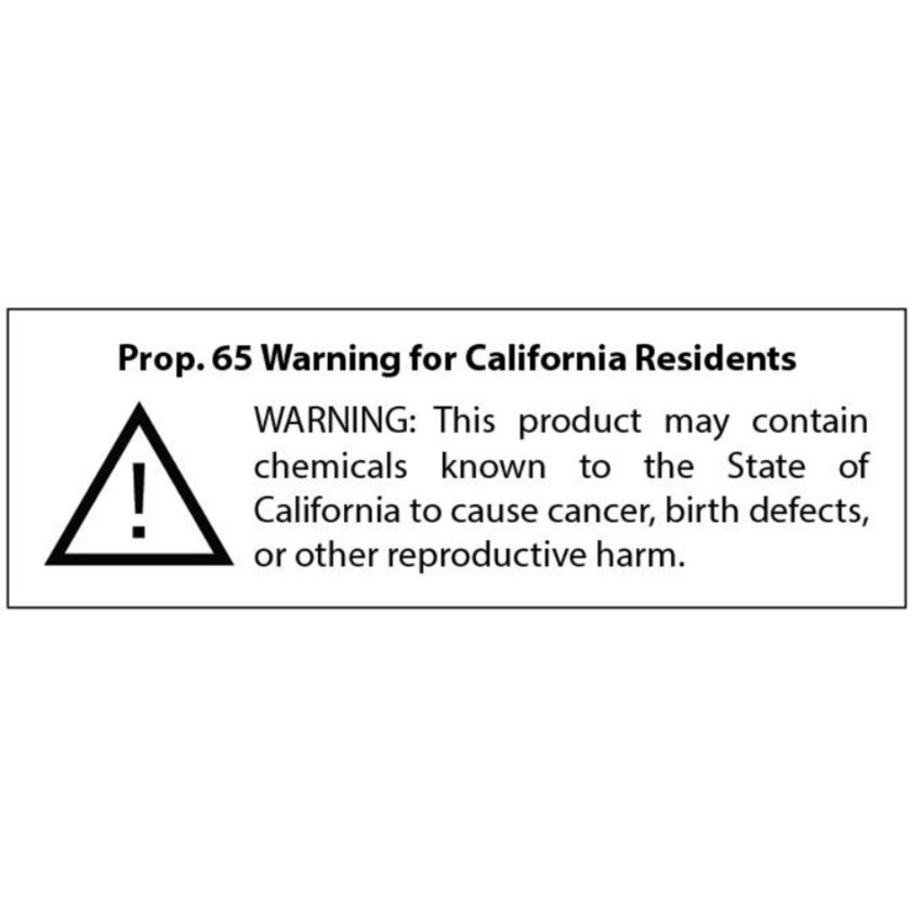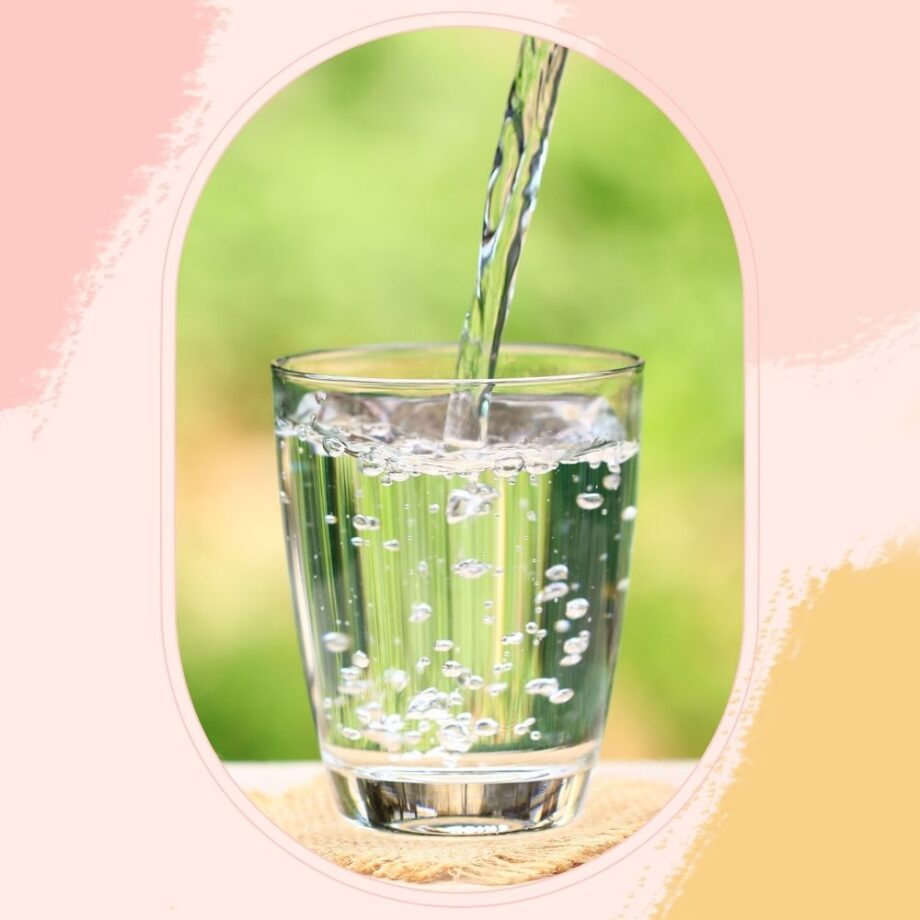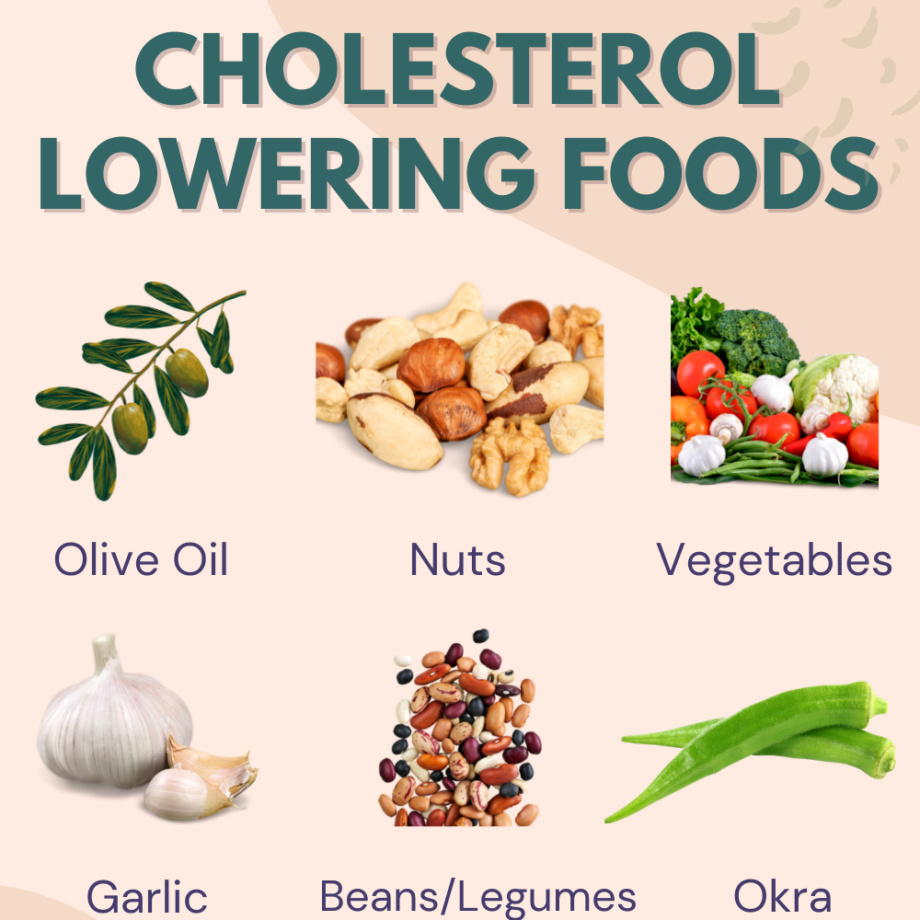Are you experiencing reactions to foods? Dealing with Mast Cell Activation Syndrome (MCAS) can be a constant struggle, especially when it comes to eating. As someone who has experienced doing strict elimination diets, I understand the frustration and confusion that comes with not knowing what to eat. In this blog post, I will share what foods to eat and what foods to avoid to help you take control of your symptoms until the root cause is addressed.

Mast Cell Activation Syndrome Diet Tips
The first thing to remember is to eat nutritious, whole foods. Processed foods contain additives, preservatives, and chemicals that can trigger reactions and increase inflammation. Eating organic foods, including fruits, vegetables, whole grains, and healthy fats, can help reduce inflammation.
You should avoid foods that contain histamines or release histamine in the body. These foods may include aged cheese, fermented foods, alcohol, and processed meats such as hot dogs. Histamines can trigger mast cells and cause a reaction, which can lead to symptoms such as hives, itching, and breathing difficulties.
Additionally, you should avoid foods that cause inflammation, such as refined sugars, fried foods, and high-fat foods. These foods can cause an increase in inflammation in the body, which can trigger mast cells and lead to MCAS symptoms.
It is also important to note that some healthy foods can trigger reactions in MCAS patients. For example, some fruits and vegetables, such as avocados, bananas, and tomatoes, contain histamine and can cause a reaction. These healthy foods may not be suitable for everyone with MCAS. The most important part is to track your personal reactions to foods and avoid the ones that cause upset.
Keeping a food diary can help you track which foods cause a reaction. This record can help you identify patterns and create an optimal eating plan for your condition.
Histamine and Your Health: Why Proper Balance is Key
Our body’s natural process involves producing histamine, which is not just important for digestion but also plays a significant role in the immune and nervous systems. Maintaining the proper balance of histamine is essential for good health, but with MCAS, histamine levels can spiral out of control, leading to inflammation.
Let’s dive into the science behind histamine levels and how its proper balance can aid in overall health.
Histamine is released by mast cells in response to innumerable things, like an allergic reaction or an infection, and plays a crucial role in immune responses.
It supports digestion by producing stomach acid, secreting enzymes, and promoting nutrient absorption. Additionally, it helps regulate sleep, mood, and even body temperature.
However, when histamine levels get out of balance, it can cause inflammation, headaches, fatigue, mood swings, and other symptoms related to MCAS.
Moreover, dietary habits can significantly impact histamine levels. Certain foods contain histamines while others can stimulate the release of histamines or block the production of diamine oxidase (DAO), the enzyme which breaks down histamine.
Supplements, medications, and environmental factors like stress and heavy pollution can also impact histamine levels. Thus, it’s essential to monitor our diet, identify high histamine foods, and keep pathways for breaking down histamine healthy.
High Histamine Foods
As discussed, high histamine foods are known to stimulate inflammation and MCAS symptoms. These foods include red wine, aged cheeses, fermented foods, canned foods, processed meats, leftover meats, citrus fruits, and nuts.
However, the research behind histamine-rich foods and their impact is not well controlled, causing confusion and fear in the MCAS community. Therefore, experts suggest experimenting with foods to identify what works for an individual and what doesn’t.
Additionally, as mentioned earlier, the body sometimes responds to non-histaminic components in high histamine foods instead of histamine itself. This makes it challenging to gauge the impact accurately.
However, not all hope is lost. Following a low histamine diet supplemented with fresh fruits, vegetables, and lean proteins can help maintain healthy histamine levels while providing essential nutrients that the body requires.
Taking good care of gut health can prevent inflammation and other diseases, including MCAS. It is vital to note that, in addition to dietary choices, certain environmental toxins can trigger inflammation and cause MCAS symptoms.
Thus, in combination with a low histamine diet, adopting healthy habits like regular exercise, stress relief, and a toxin-free environment can aid in maintaining healthy histamine levels. Ultimately, you need to get to the root cause of WHY the mast cell activation is happening in the first place. These tips are all meant to aid you while getting to the root cause of the problem and ultimately healing it so this is not a forever problem.
While dietary habits can significantly impact histamine levels, it is vital to note that the impact is individualized, and not all suggested high-histamine foods will necessarily be triggers. Therefore, it’s always best to experiment and keep track of your body’s response to different foods.
High Histamine Foods List
Have you ever experienced sudden and unexplained headaches, skin rashes, dizziness or shortness of breath after consuming certain foods? While the idea of becoming unwell after eating might seem like an odd concept, it is possible for some people, especially women, to suffer from histamine intolerance. Histamine’s role in inflammation response has been widely studied. What is lesser known is that food can also contain histamine levels that can trigger such symptoms.
One rule of thumb is any foods with bacteria in them can create high histamine. So anything that is out of date, spoiled, moldy, or not really fresh is higher histamine. This also means leftovers become higher histamine the longer they sit. That rotisserie chicken at the grocery that has been sitting all day is building high histamine levels.
Meat that has been sitting more than a day in the refrigerator section increases in histamines too. Fermenting, culturing, and aging increases histamines too. Beef is especially high histamine because it gets aged for at least 2 weeks before going to market.
Look out for these types of high-histamine foods:
- Fermented alcoholic beverages, like wine, champagne, beer, whiskey, brandy. Beverages with high histamines levels can also trigger alcohol intolerance, which manifests in symptoms similar to histamine intolerance.
- Fermented foods: sauerkraut, vinegar, soy sauce, kefir, yogurt, kombucha, etc. Fermented foods, while considered “good” bacteria, can still increase histamine levels, which could be risky for those with histamine intolerance.
- Soured foods: sour cream, sour milk, buttermilk, soured bread, etc. Anything that has soured contains histamines. So look out for that last bit of buttermilk left on the grocery shelf.
- Balsamic Vinegar and Vinegar foods: pickles, mayonnaise, olives, ketchup. While vinegar is a great preservative, it can also increase histamine levels in the food it preserves. Those daring to try the last slice of pickle may need to think twice.
- Cured meats: bacon, salami, pepperoni, luncheon meats and hot dogs. Cured or preserved meats have increased histamine levels due to their preservation methods.
- Aged cheese, including goat cheese. Aged cheese contains more histamines than younger cheese. Even if you love goat cheese, a word to the wise – check your cheese’s history before partaking.
- Smoked fish, fish not gutted within 30 minutes of catch. As the name suggests, smoked fish has increased histamine levels because of the smoking process. Fresh fish can also have higher histamine levels, especially if the fish is not gutted immediately after catching.
- Ground meat. As with any food, the more surface area there is, the higher the histamine levels. This is especially true for ground meat.
- Beef. This is an interesting one because we typically think of beef as a red meat without any obvious fermentation or culturing process – yet aged beef contains more histamine than ‘fresh’ beef.
- Smoked or processed meats: salami, bacon, ham, sausage.
- Dried fruit: apricots, prunes, dates, figs, raisins.
- Uncooked egg whites (histamine liberator). While they are rare, uncooked egg whites may contain histamine liberators which trigger histamine intolerance symptoms.
- Leftovers. As previously mentioned, any food that had bacteria in them will create high histamine levels, so leftovers do fall into this category.
High Histamine Fruits, Vegetables and Nuts: What to Avoid and Why:
- Nuts, including walnuts, cashews, and peanuts, contain high levels of histamines that trigger mast cells to release more histamine into your system. If you are someone who loves trail mix or has a nut butter addiction, you’ll want to find alternative snacks to munch on.
- Spinach: Don’t be fooled by the antioxidant value of spinach, which also contains high levels of histamines. Whether it’s in a smoothie or a salad, you might be unknowingly exacerbating your allergy symptoms.
- Mushrooms can hide histamines, and while they are touted as a vegetable with antioxidant and immune-boosting properties, they should be enjoyed in moderation by anyone with allergy issues.
- Avocados may be the newest affliction to hit allergy sufferers. Besides being a beloved and trendy fruit in contemporary cuisine, they have high levels of histamine due to their high fat content.
- Pineapples and strawberries are more commonly known to cause allergic reactions, they’re not as high in histamines compared to the other foods on this list.
- The worst of the bunch are processed foods, and you want to avoid them as much as possible. Canned foods, boxed nut milks, cookies, prepared sauces, and protein bars are higher histamine and inflammatory too. Anything that sits in a package becomes higher histamine, and these foods are highly processed to make them shelf-stable, which destroys the nutrients that your body so desperately needs.
- In addition to avoiding processed and packaged foods, watch out for these additives that can wreak havoc with mast cells: Carrageenan, Sodium Benzoate, Potassium Sorbate, Lecithin, MSG, Citric Acid, Sodium Triphosphate, Potassium Triphosphate, Sodium Nitrite, Maltodextrin, Calcium Chloride, Xanthan Gum, Food colorings, Smoke Flavoring, Yeast Extract.
Beyond Histamines: How Other Inflammatory Foods Affect MCAS
It’s important to consider not only histamines but also other inflammatory foods that can trigger reactions.
Lectins, oxalates, salicylates, sulfur, and FODMAPs:
- Lectins: Lectins are proteins found in certain plants, such as legumes, grains, and nightshade vegetables. Research has shown that lectins activate mast cells, making them a potential trigger for MCAS. If you suspect that lectins are affecting you, you may benefit from a low lectin diet. This involves avoiding or limiting foods that are high in lectins, such as beans, lentils, and tomatoes.
- Oxalates: Oxalates are tiny crystals found in plants, such as spinach, beetroot, and rhubarb. While they are generally harmless, people with a genetic predisposition to high oxalates can have trouble with oxalate foods. Additionally, yeast overgrowth and leaky gut can contribute to high oxalates. If you suspect that oxalates are causing issues, consider avoiding or limiting oxalate-rich foods.
- Salicylates: Salicylates are naturally occurring chemicals found in many fruits, vegetables, and herbs. While they are typically harmless, people with MCAS may have a heightened sensitivity to salicylates. If you are sensitive to salicylates, you may experience symptoms such as hives, swelling, and gastrointestinal issues. Limiting or avoiding high salicylate foods, such as berries, apples, and cinnamon, may help manage your symptoms.
- Sulfur: Sulfur is an essential mineral found in many foods, such as meat, poultry, and cruciferous vegetables. While sulfur is important for overall health, some people with MCAS may have a sulfur sensitivity. This sensitivity can cause symptoms such as swelling, headaches, and digestive issues. If you suspect that sulfur is causing issues, consider limiting or avoiding sulfur-rich foods.
- FODMAPs: FODMAPs are fermentable carbohydrates found in many foods, such as wheat, dairy, and certain fruits and vegetables. While FODMAPs are not inflammatory themselves, they can cause digestive issues in people with certain conditions, such as MCAS. If you suspect that FODMAPs are causing issues, consider following a low FODMAP diet. This involves avoiding or limiting high FODMAP foods, such as wheat, onion, and garlic.
What Can I Eat with MCAS?
If you have MCAS, you may feel overwhelmed by the high histamine food lists. It can be discouraging to see all the foods you can’t have, and it’s easy to feel deprived. However, I’m here to tell you that there are plenty of nutritious and flavorful foods you can still enjoy!
The key is to focus on what you can eat, rather than what you can’t. Now that you know which foods to avoid, I will provide you with some guidance on how to choose healing, nutrient-dense foods that will support your immune system and aid in lowering histamine levels.
First and foremost, it is important to choose fresh, whole, nutrient-dense foods. As fruits and vegetables age, they lose nutrients. Therefore, the fresher the food, the more vitamins, minerals, and antioxidants it contains.
When dealing with MCAS, it is crucial to consume as many nutrients as possible in order to support a healthy immune system and promote the production of histamine-degrading enzymes such as DAO and HNMT.
Now, you may be wondering what foods are considered nutrient-dense.
Here are some examples: leafy green vegetables like kale, colorful vegetables such as bell peppers and sweet potatoes, cruciferous vegetables like broccoli and cauliflower, and fresh fruits such as berries and melons.
Not only are these foods packed with nutrients, but they are also low in histamine, making them perfect for those with MCAS.
In addition to fresh produce, it is important to include lean proteins such as chicken, turkey, and fish in your diet. When selecting meats, be sure to choose those that are fresh and hormone-free.
When it comes to carbohydrates, choose whole grains such as brown rice and quinoa over refined grains like white bread and pasta. Whole grains are higher in fiber and provide long-lasting energy. You can also enjoy starchy vegetables like sweet potatoes for added health benefits.
Lastly, don’t be afraid to get creative in the kitchen! There are a plethora of herbs and spices that can add flavor to your meals without raising histamine levels. Try using fresh herbs like basil and parsley, as well as spices like cumin and turmeric. You can also experiment with different cooking methods such as grilling, baking, or roasting to switch up the flavors and textures of your meals.
Consume moderate portions of clean protein, preferably from pastured meats, such as chicken, lamb, and turkey. When it comes to beef, caution should be exercised owing to the aging process. Ensuring the freshness of the meat is crucial, and one way to achieve this is by contacting the butcher and inquiring about the delivery day.
Additionally, checking the sell-by dates and selecting the freshest packages is also advisable.
When you purchase meat or fish, it’s essential to cook or freeze it as soon as possible to prevent it from spoiling and increasing histamine levels. Avoid slow cooking methods, such as stews and cooking in a slow cooker, as these can also increase histamine levels.
By cooking or freezing meat and fish right away, you’re decreasing the risk of histamine levels rising and potentially causing allergic reactions.
In addition to meat and fish, eggs are an excellent source of protein. However, some people can react to eggs, so it’s essential to test them for yourself.
Pasture-raised chicken, duck, or quail eggs are healthy options that can be incorporated into your diet. If you have an egg allergen, there are plenty of other protein options available.
Healthy fats are necessary for overall health, including healthy brain cells and hormone production. Some vitamins, such as vitamins A, D, E, and K, are fat-soluble, meaning they’re best absorbed when eaten with fats. Sources of healthy fats include grass-fed butter, extra-virgin olive oil, virgin coconut oil, grass-fed ghee, cold-pressed flax oil, cold-pressed avocado oil, and unrefined palm oil. Inflammatory oils such as canola oil, corn oil, safflower oil, and peanut oil should be avoided.
When it comes to nuts and seeds, walnuts, peanuts, and cashews contain high levels of histamine, making them less than ideal for some people. However, flax seeds, macadamias, pistachios, coconut, and pecans in moderation are low histamine, low oxalate, and low lectin choices. It’s important to keep the pecans and macadamias to 1/4 cup to stay low oxalate.
In conclusion, while healing with MCAS can be challenging, taking control of your diet can make a big difference in managing and reducing your symptoms. Eating whole foods, avoiding histamine-rich foods, avoiding inflammatory foods, and identifying your personal food triggers can be key in making informed food choices. There is no one-size-fits-all list of foods to avoid. Keep a food journal and track which foods you do and do not tolerate.
Working with a healthcare professional can also be helpful in developing a personalized nutrition plan for your situation. Not only can they help you navigate eating well for your body, but they can help you get to the root cause of why you don’t tolerate certain foods and address that so you don’t have to live like this forever.
I have worked with many women with mast cell activation syndrome and there is always an underlying root cause that needs to be dealt with. Once we do that, the mast cell activation clears itself up.
There is hope. There is healing. Start at the root cause.



